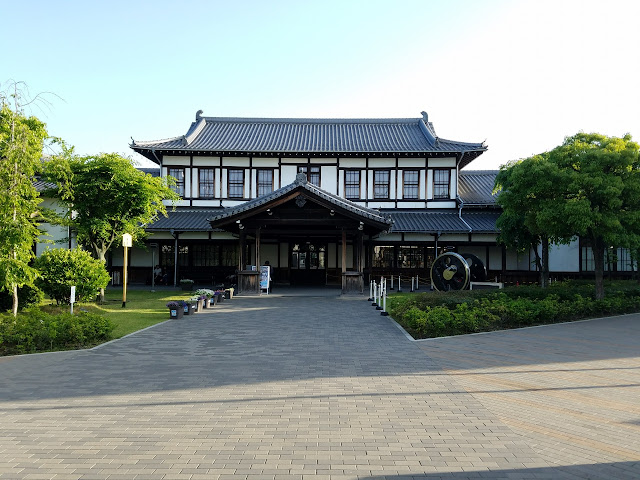Previously on Sekai Ichi, I spent a day in Kyoto. After visiting the Arashiyama district, the Toei Kyoto Studio Park, and the Kyoto Railway Museum, I wrapped it up by heading to the Gion district. I had been there before on a previous trip, but there was one major gap I sought to fill this time around: a cultural performance held twice-nightly at a theatre called the Gion Corner (弥栄会館 ギオンコーナー, Yasaka Kaikan Gion Kōnā).
The show starts with a tea ceremony on the sidelines, running concurrently with the next couple of acts below. The consumption of green tea in Japan was documented as far back as the early 9th century AD, having been brought over from China. Later on, a man named Sen no Rikyu (千利休, 1522-1591) codified the process of the tea ceremony (茶道, chadō, lit. 'way of tea'). Here, the hostess wisks around matcha (抹茶), green tea powder, to mix it in with hot water.
The first act on the main stage, accompanying the tea ceremony, is a pair of koto players. The koto (箏) is a 13-stringed instrument based on the Chinese guzheng, introduced to Japan in the 7th-8th centuries AD. Next to them, a man conducts ikebana (生け花, lit. 'living flowers'), or flower arrangement. The flowers he set up were then placed in the alcove, or tokonoma (床の間) to our left, a common feature in Japanese-style rooms.
The next act is a performance of court music, or gagaku (雅楽, lit. 'elegant music'). Evolved in the late 6th century from Chinese yayue music, gagaku is most commonly performed for Shinto rituals, and for the Imperial household. The orchestra on the left is led by this orange-clad, masked conductor, who directs the players as part of a dance known as bugaku (舞楽, lit. 'dance music'). The koto, described above, does sometimes feature into gagaku, but was not present in this particular performance.
Next is kyogen (狂言), a short comedic play. Kyogen was developed as interludes to be performed in between noh plays, to lighten the mood. In the story performed here, two thieves are caught trying to steal sake from a lord (centre). He has one of the thieves (right) bound with his arms behind his back, and the other's (left) tied to either side of a pole rested across his shoulders. Hilarity ensues when they try to come up with ways to drink the sake.
After that are a couple rounds of kyomai (京舞, lit. 'Kyoto dance'), the dance performed by geisha (芸者, lit. 'art person') -- in Kyoto, the term geiko (芸子, lit. 'art girl') is more common), and apprentice maiko (舞妓, lit. 'dance woman') for private teahouse functions. Gion, the district where this very theatre is located, was one of Kyoto's five old entertainment districts with geisha in widespread employment, so it makes sense for them to be featured here. As for the kyomai, there is limited footwork beyond the occasional turning around, but a heavier emphasis on intricate hand and arm movements.
Finally, the repertoire ends with a bunraku (文楽) performance. Also known as ningyō jōruri (人形浄瑠璃), bunraku can be thought of as kabuki theatre in puppet form. In this story, a young woman, the only character on stage, is so desperate to see her firefighter lover again that she rings a fire-alarm bell. The tower in the background is designed so that the puppet's handlers can get behind it and create the illusion of her climbing it. The use of handlers clad in black robes and masks, to appear invisible against the stage's backdrop, may have contributed to the image of ninjas wearing the same, as I have suggested before.
In all, the show lasts about 50 minutes, held twice daily at 6:00 and 7:00 PM. Tickets must be purchased at the box office, but there is enough seating that selling out should not be an issue. In addition to the show, you may also wish to visit the on-site Maiko gallery, a small museum of hairstyle samples, clothing, accessories, videos, and other memorabilia relating to geiko and maiko. But, as for me, this performance wrapped up another day in Japan. Check back for a report on one of Kyoto's biggest festivals, the top-ten museums about anime and manga, and more Know Your Trains, next time on Sekai Ichi!
Hours: Performances start at 6:00 PM and 7:00 PM every day. From December to mid-March, they are held only on weekends and holidays.
Cost: ¥3,150.
Address: Yasaka Hall, 570-2 Gion-machi Minami-gawa, Higashiyama-ku, Kyoto 〒605-0862
Access: From Kyoto Station, take bus #100, 106, 110 (stand D1), or 206 (stand D2) to the Gion bus stop (20 minutes, ¥230). The area is also served by Gion-Shijo station on the Keihan Main Line (KH), and Kawaramachi Station on the Hankyu Kyoto (HK) line. It takes about 7 minutes to walk to Gion Corner from either the Gion bus stop or Gion-Shijo Station, or 10 minutes from Kawaramachi Station.
Directions: From the Gion bus stop, head down Shijo-dori, away from Yasaka Shrine. Turn left at the next traffic light, onto Hanamikoji-dori. The theatre entrance will be on the left, before the Kennin-ji temple grounds.





























































